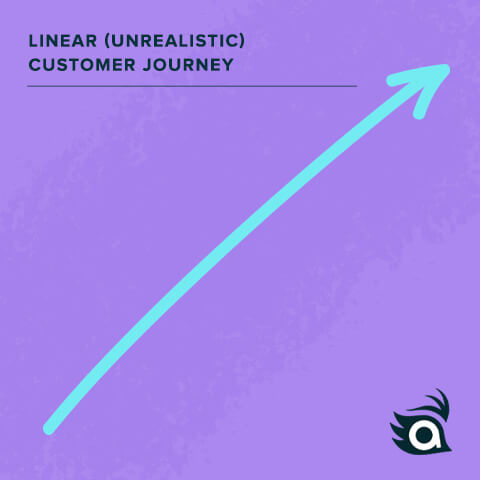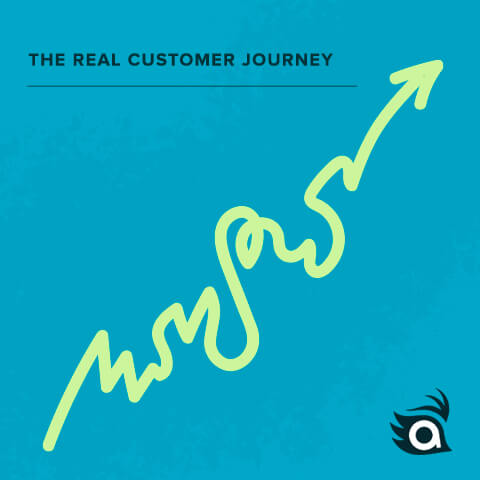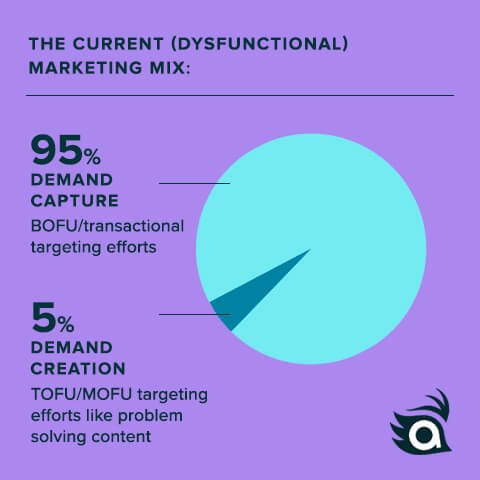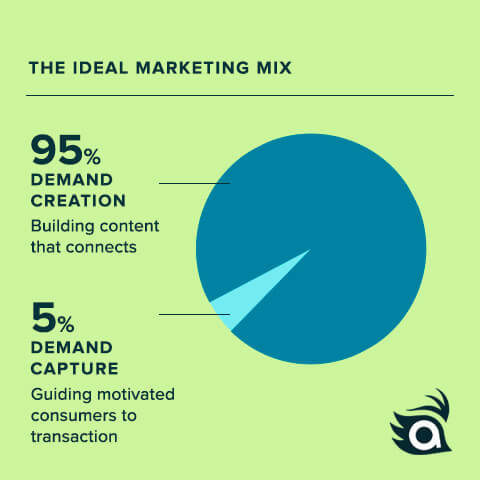
Why Building Authentic Customer Connections Is Hard
Apr 4, 2023|Read time: 7 min.
Key Points
- Creating customer connections — the kind built on trust and mutual value — is a major challenge for today’s brands and current “best practice” marketing tactics are making this harder.
- The marketing funnel is outmoded, real customer journeys are non-linear, there’s confusion about what audiences actually want, and consumer attention needs redefining.
- A rethinking of traditional marketing philosophies is in order so that brands can build true connections with customers, powered by consumer search intent data.
Attention is everything for creating customers and brands that fail to capture the right kind of attention suffer the consequences. The problem begins with an outdated marketing funnel model. It’s exacerbated by fundamentally bad data and lack of investment in authentic, long-term customer connection.
Additionally, consumer attention is only valuable if you reward it with valuable content. Millions of eyes on something people aren’t prepared for or aren’t actually seeking have very little value. That’s what much of modern marketing does — interrupts you with stuff you don’t care about.
These factors (and many others) make it harder to foster authentic customer connection in high-competition, high-value spaces. Brands either build real connection or blend into the crowd of dozens of undifferentiated competitors.
We’re constantly evolving our thinking on customer connections, the customer journey, and what real customer attention looks like. Below are some insights for forward-thinking marketers.
The marketing funnel is outdated
The marketing funnel isn’t dead. It still works to an extent. It just becomes outmoded when we admit some hard truths about the customer journey.
In the ideal picture using customer personas, we think consumers seek a product, compare similar offerings, then make a decision.
Reality has never been this simple.
In the real world, the buyer’s journey is chaotic. It doesn’t follow the one-size-fits-all concept or a linear path. It gets interrupted, restarted, put on hold, left behind, picked up again, and more. The point is that the funnel isn’t a straight shot from awareness to transaction; it’s a squiggly line at best.
Marketers need to embrace this truth in order to get correctly aligned with their audiences.
Non-linearity and the customer journey
Here’s where marketing is now, but here’s where your audience actually is:


Approaching the chaotic customer journey
The gap between the old funnel and the real customer journey creates missed opportunities to foster connection, brand trust and brand equity, and meaningful engagement. Serving audiences content, ads, or promotional material meant to create transactions doesn’t work when the marketing funnel is so misleading.
Instead of trying to force customers down the funnel, marketers should assume the role of problem solver. Listening to consumers, learning their problems, and offering solutions to customers’ biggest pain points. More transactions require more trust, which is created when customers get substantial value through brand efforts before a transaction.
Brands need to invest in relationships and not just sales. This philosophy shift means creating rich, solution-oriented content that audiences seek and simply be available, providing value on the audience’s terms — whenever, wherever, and however they want it.
The Brand Intelligence Report
Exclusive AI insights, search trends, and brand strategies, delivered to your inbox.
The 95:5 rule
Heard of the 80:20 rule? Well, marketing is also realizing something called the 95:5 rule. It states that in-market audiences are split into the 95% not yet looking to buy and the 5% who are.
Almost all of the audience is in the awareness and research stage, with a tiny fraction at the transaction level. This has been applied to B2B but resonates into the B2C and D2C world as well.
The problem? Marketers think that prioritizing transactions (forcing people down the funnel) creates sales. The data shows something completely different about consumers. We need to put consumer needs first and evolve our strategies to mirror how our audiences actually behave.
The current (dysfunctional) marketing mix:
- 95% demand capture – BOFU/transactional targeting efforts
- 5% demand creation – TOFU/MOFU targeting efforts like problem-solving content
Our question — How do you foster connection and trust serving transactional material no one wants?
The ideal marketing mix:
- 95% demand creation
- 5% demand capture


The solution — Creating the ideal mix requires flipping the “old way” on its head. Embracing a path that centers real world human behavior and consumer insights.
What consumers actually want
We think of consumer audiences as solution seekers and brands as solution providers. Consumers look for solutions in the shape of information and/or products/services.
Applying our ideal 95:5 mix, informational content should be a brand’s biggest priority as most consumers aren’t ready to buy. Brands can build alignment and strong trust by providing exactly what consumers want. Providing up-front value creates trust that’s rewarded with sales. Transactional tunnel vision can’t do that.
Customer desires revealed
Great, consumers want solutions… But to what?
There are many valuable sources of consumer intent data: reviews, user-generated content, surveys, and traditional focus groups. But one outshines them all in providing always-on, real-time, honest information: search intent data.
Google collects, in detail, what users are looking for with every search they make. Given the intimate and valuable nature of search, users are honest about their needs, asking detailed, sometimes embarrassing, private, or unique questions they might not share with their closest friends.
This highly accurate data can tell you exactly what your consumers want and can lead your marketing to connect with them, whenever and wherever they are. And the best part is it not only applies to marketing, but can be applied across all aspects of brand operations, discovering new markets, trends, and consumers.
Search intent data reveals exactly what your audience needs and what you can do to earn their authentic attention and build trust.
Make Connections that Matter
Uncover what your customers are looking for in real time and meet their needs with valuable content.
Redefining consumer attention
Not all attention is the same, and the extent of its value depends on the type and the infrastructure a brand has to cash in on it.
Attention falls into two categories:
- Earned – Authentic, organic attention that provides enough value to hold a consumer’s attention and turn it into brand equity, trust, and conversions. This attention is created by building audience trust and provides major ROI.
- Unearned – Attention sourced through traditional paid channels. Because this attention is purchased, it isn’t as powerful as what you earn by helping your audience solve their problems. It inefficiently gets many eyes on your brand but doesn’t foster trust. At worst, it can turn customers off. ROI here is limited and is not optimized.
It’s not that unearned attention is bad, it’s simply that earning attention with solution-rich content creates real customer connections in the process while unearned attempts to force it. Creating exceptional content not only earns attention, but also boosts the impact of the attention you pay for.
The attention ratio and asset infrastructure
The ratio and prioritization between earned and unearned attention determines a brand’s ROI, efficiency, and cost to acquire customers. Prioritizing investment in valuable content that earns consumer attention builds trust and preps your audience. It will ultimately help make paid, unearned attention valuable.
Building an infrastructure of content focused on helping your audience paves the way for better, more optimized cross-channel marketing results.
If you lack an infrastructure of owned assets and content that connect with consumers, your budget should be heavily focused on building earned attention over unearned.
Winning with earned attention
Brands can achieve earned attention by using search intent data to fully grasp the problems their audience has, creating highly relevant content, and optimizing it for discoverability when the audience asks for it.
Done consistently with consumer search intent in mind, brands can become trusted sources of value to the 95% of consumers looking for solutions. Brands are naturally rewarded for this value as audience members make purchase decisions.
This longer play, which actually helps your audience, delivers far better results than throwing money at a channel to buy eyeballs and expecting great ROI.
Paid channels have a role to play, but leading with sophisticated value creation and relationship-building strategy fosters real consumer attention and increases marketing ROI across all channels. Strong customer relationships generate their own value AND ensure that paid marketing hits an audience that is primed for action.
Final thoughts
These are just a few of the symptoms resulting from the larger problem of fractured marketing. Industry practices have simply not caught up with the behavior of the real people that make up brand audiences.
Traditional marketing models and perspectives are showing their age, and that drives the misalignment between brands and consumers we’re seeing across some of the largest business sectors.
Thankfully there’s a new path to tread through search intent, solutions-driven content publishing, digital asset optimization and management, and more. Altogether, with a holistic philosophy and approach, achieving meaningful, lasting customer relationships becomes much more actionable and realistic for the world’s largest brands.




